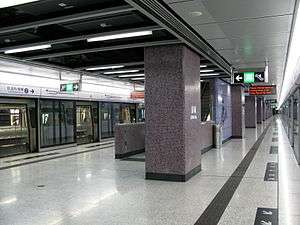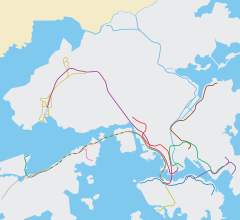LOHAS Park station
LOHAS Park (Chinese: 康城; Cantonese Yale: Hōngsìng)[1] is a rapid transit station on the Tseung Kwan O Line of the MTR system in Hong Kong. It opened on 26 July 2009.
| MTR rapid transit station | ||||||||||||||||||||||||||||||||||||||||||||||||||||||||||||||||||||||||||||||||||||||||||||||||||||
 LOHAS Park Station | ||||||||||||||||||||||||||||||||||||||||||||||||||||||||||||||||||||||||||||||||||||||||||||||||||||
| Chinese name | ||||||||||||||||||||||||||||||||||||||||||||||||||||||||||||||||||||||||||||||||||||||||||||||||||||
| Traditional Chinese | 康城 | |||||||||||||||||||||||||||||||||||||||||||||||||||||||||||||||||||||||||||||||||||||||||||||||||||
| Simplified Chinese | 康城 | |||||||||||||||||||||||||||||||||||||||||||||||||||||||||||||||||||||||||||||||||||||||||||||||||||
| Cantonese Yale | Hōngsìng | |||||||||||||||||||||||||||||||||||||||||||||||||||||||||||||||||||||||||||||||||||||||||||||||||||
| Literal meaning | healthy city | |||||||||||||||||||||||||||||||||||||||||||||||||||||||||||||||||||||||||||||||||||||||||||||||||||
| ||||||||||||||||||||||||||||||||||||||||||||||||||||||||||||||||||||||||||||||||||||||||||||||||||||
| General information | ||||||||||||||||||||||||||||||||||||||||||||||||||||||||||||||||||||||||||||||||||||||||||||||||||||
| Location | 1 LOHAS Park Road, LOHAS Park, Tseung Kwan O Sai Kung District, Hong Kong | |||||||||||||||||||||||||||||||||||||||||||||||||||||||||||||||||||||||||||||||||||||||||||||||||||
| Coordinates | 22°17′45″N 114°16′08″E | |||||||||||||||||||||||||||||||||||||||||||||||||||||||||||||||||||||||||||||||||||||||||||||||||||
| Operated by | MTR Corporation | |||||||||||||||||||||||||||||||||||||||||||||||||||||||||||||||||||||||||||||||||||||||||||||||||||
| Line(s) | ||||||||||||||||||||||||||||||||||||||||||||||||||||||||||||||||||||||||||||||||||||||||||||||||||||
| Platforms | 2 (Island platforms) | |||||||||||||||||||||||||||||||||||||||||||||||||||||||||||||||||||||||||||||||||||||||||||||||||||
| Connections | Bus | |||||||||||||||||||||||||||||||||||||||||||||||||||||||||||||||||||||||||||||||||||||||||||||||||||
| Construction | ||||||||||||||||||||||||||||||||||||||||||||||||||||||||||||||||||||||||||||||||||||||||||||||||||||
| Structure type | At-grade | |||||||||||||||||||||||||||||||||||||||||||||||||||||||||||||||||||||||||||||||||||||||||||||||||||
| Platform levels | 1 | |||||||||||||||||||||||||||||||||||||||||||||||||||||||||||||||||||||||||||||||||||||||||||||||||||
| Disabled access | Yes | |||||||||||||||||||||||||||||||||||||||||||||||||||||||||||||||||||||||||||||||||||||||||||||||||||
| Other information | ||||||||||||||||||||||||||||||||||||||||||||||||||||||||||||||||||||||||||||||||||||||||||||||||||||
| Station code | LHP | |||||||||||||||||||||||||||||||||||||||||||||||||||||||||||||||||||||||||||||||||||||||||||||||||||
| History | ||||||||||||||||||||||||||||||||||||||||||||||||||||||||||||||||||||||||||||||||||||||||||||||||||||
| Opened |
| |||||||||||||||||||||||||||||||||||||||||||||||||||||||||||||||||||||||||||||||||||||||||||||||||||
| Services | ||||||||||||||||||||||||||||||||||||||||||||||||||||||||||||||||||||||||||||||||||||||||||||||||||||
| ||||||||||||||||||||||||||||||||||||||||||||||||||||||||||||||||||||||||||||||||||||||||||||||||||||
| ||||||||||||||||||||||||||||||||||||||||||||||||||||||||||||||||||||||||||||||||||||||||||||||||||||
| Location | ||||||||||||||||||||||||||||||||||||||||||||||||||||||||||||||||||||||||||||||||||||||||||||||||||||
 LOHAS Park Location within the MTR system | ||||||||||||||||||||||||||||||||||||||||||||||||||||||||||||||||||||||||||||||||||||||||||||||||||||
Location
The station serves a residential project called LOHAS Park (formerly "Dream City") at Area 86. The first tenders for the construction of Phase 1 were completed in January 2005. Next to the Tseung Kwan O Line Depot, it is the easternmost railway station in Hong Kong.[2]
Transit-oriented development
In accordance with both MTR's "Rail + Property" funding scheme and one of the goals of the Tseung Kwan O Line being to connect large housing estates on the eastern side of Victoria Harbour to Hong Kong Island, LOHAS Park is a site for transit-oriented development. LOHAS Park will be the largest MTR property development, a 32.08 ha (79.3 acres) site with 50 towers containing 21,500 apartments and approximately 45,000 m2 (480,000 sq ft) of retail.[3]
History
During the construction stages, the station was temporarily named Tseung Kwan O South, after its location in the southern part of the Tseung Kwan O New Town.[4]
Since the station opened on 26 July 2009, the Tseung Kwan O Line has been split into two branches at Tseung Kwan O, with the original northern branch towards Po Lam, and the new southern branch towards LOHAS Park. This is the second branch in the MTR system, after Lok Ma Chau Station on the East Rail Line.
Service controversy
To operate the branch, MTR instituted a "3+1" service whereby every fourth train runs to LOHAS Park.[5] After 8 December 2014, MTR instituted a "2+1" service in peak hours. During off peak and Sundays, a shuttle train between LOHAS Park and Tiu Keng Leng would operate. This is one example when the "terminus" of some trains are within intermediate stations.
Although MTR compensated for the slight reduction of service by decreasing headways by ten seconds to 2.5 minutes, residents and passengers have complained that the branched nature of the line has increased delays. MTR claims that its on-time rate is still 99.9%.[6]
Station layout
| U3 Podium |
Podium | Exit C, Passageway to LOHAS Park |
| U2 | Concourse | Customer service centre, MTRShops |
| U1 Platform |
Platform 1 | ← Tseung Kwan O line towards North Point peak hours, Tiu Keng Leng other times (Tseung Kwan O) |
| Island platform, doors will open on the left/right | ||
| Platform 2 | ← Tseung Kwan O line towards North Point peak hours, Tiu Keng Leng other times (Tseung Kwan O) | |
| G | Exit | Exit A, transport interchange |
There are two platform faces on an island platform. Like in other underground MTR stations, platform screen doors have been installed.[7]
Entrances and exits
There are three entrances/exits. One of them leads to the public transport interchange located adjacent to the station, while the remaining two lead to LOHAS Park residential development. Exit B will be opened in the second half of 2019 for access to new MTR shopping mall The LOHAS, with the largest indoor ice rink in Hong Kong and the largest cinema in Tseung Kwan O.
Podium (U3)
- C: LOHAS Park
- C1: LOHAS Park, LOHAS Youth S.P.O.T.,The Capitol, Le Prestige, Le Prestige, La Splendeur
- C2: LOHAS Park

Ground (G)
- A: Public Transport Interchange

Transport connections
Minibus and taxis can be accessed from Exit A.
Bus Routes
To Tsim Sha Tsui East:
- 98D Special Route*
To Mei Foo:
- 98S*
To Tsuen Wan West Station:
- 290X
To Hang Hau Station:
- 298E
To Tseung Kwan O Industrial Estate:
- 298E/796X/797M
To Tsim Sha Tsui East:
- 796P*/796X
To Tseung Kwan O Station:
- 797M
To Sha Tin Station:
- 798B*
To Airport:
- A29P (5:25 and 6:35 only)
Former bus routes
Circular via The Capitol, Le Prestige, Le Primer
- NR215 (Termination Effective 28 October 2012)
Gallery
| Wikimedia Commons has media related to LOHAS Park Station. |
 LOHAS Park Station Exit C
LOHAS Park Station Exit C LOHAS Park Station concourse
LOHAS Park Station concourse- Platform 1
 LOHAS Park Station Exit A
LOHAS Park Station Exit A
See also
References
- The Chinese name of this station, "康城" comes from the Chinese name of the served nearby housing estate, "日出康城". And the English name of this station, "LOHAS Park", is the same as this housing estate, "LOHAS Park".
- "LOHAS Park Station street map" (PDF). MTR Corporation. Retrieved 30 October 2016.
- LOHAS Park property developments: Summary of development details MTR Retrieved 2011-03-04
- In the most recent business overview MTR used LOHAS Park instead of Tseung Kwan O South to identify the station. On 18 October 2008 MTR held a ceremony to name the station "LOHAS Park". "將軍澳港鐵新站命名「康城」". Sing Tao Daily. 19 October 2008. Retrieved 19 October 2008.
- LOHAS Park station and Tseung Kwan O Line "3+1" new train service arrangement MTR Retrieved 2011-03-04
- LOHAS Park takes rap - for the delays on the rails Archived 28 June 2011 at the Wayback Machine The Standard Retrieved 2011-03-04
- "LOHAS Park Station layout" (PDF). MTR Corporation. Retrieved 30 October 2016.